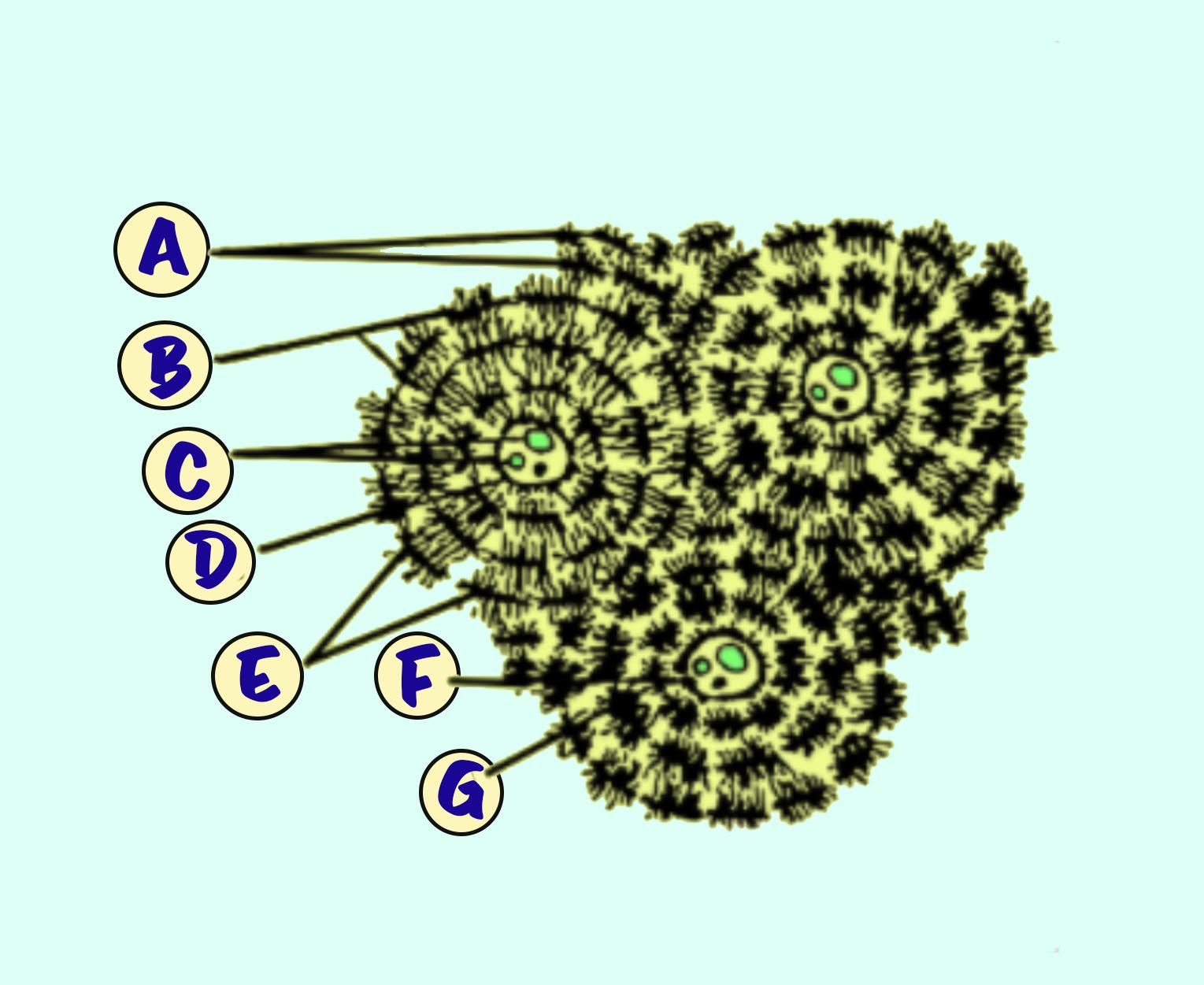
In the diagram of the section of bone tissue given above, certain parts have been indicated by the alphabets. Choose the answer in which these alphabets have been correctly matched with the parts which they indicate.

(a)A=Interstitial lamellae, B=Laemae with osteocytes, C=Blood vessels, D=Nerve, E=Canaliculi, F=Haversian canal, G=Lamellae
(b)A=Interstitial lamellae, B=Osteocytes in the lacunae, C=Blood vessels, D=Nerve, E=Lamellae, F=Haversian system, G=Canaliculi
(c)A=Interstitial lamellae, B=Osteocytes, C=Nerve, D=Blood vessels, E=Canaliculi, F=Haversian system, G=Lamellae
(d)A=Interstitial lamellae, B=Osteocytes, C=Nerve, D=Blood vessel, E=Lamellae, F=Haversian canal, G=Canaliculi

Answer
462.3k+ views
Hint: Bone is a type of specialized connective tissue that forms the structural framework of the body, movements, and weight-bearing functions. The bone mostly consists of an extracellular matrix arranged in the form of lamellae which is secreted by osteoblasts.
Complete Answer:
The structure of bone is divided into the spongy bone and compact bone. The compact bone consists of a matrix secreted by the osteoblasts arranged in the form of Lamellae. When the osteoblasts are depositing the lamellae they enclose themselves in hollow cavities known as Lacunae as shown by ‘B’. The lamellae are arranged parallel to each other and present in concentric circles around larger longitudinal canals known as the Haversian canals as shown by ‘E’ in the figure. The Haversian canals along with their surrounding lamellae are known as Haversian systems or osteons as shown by ‘F’. The Haversian canal consists of blood vessels and nerves as shown by ‘C’ and ‘D’ respectively. There are some lamellae that are not associated with any Haversian system and are present in the interstitial space between two Haversian systems known as interstitial lamellae as shown by ‘A’. There are small channels present within this matrix known as Canaliculi that provide a means of communication and the exchange of substances between different osteocytes as shown by ‘G’.
So, the correct option is ‘A=Interstitial lamellae, B=Osteocytes in the lacunae, C=Blood vessels, D=Nerve, E=Lamellae, F=Haversian system, G=Canaliculi’.
Note:
-Connective tissues are the tissues responsible for linking and supporting different tissues/organs of the body. They are further divided into loose connective tissue, dense connective tissue, and specialized connective tissue.
-Connective tissues generally contain cells that secrete fibers of structural proteins like collagen or elastin. These fibers are responsible for providing strength, elasticity, and flexibility to the tissue.
-Loose connective tissue includes adipose and areolar tissue, dense connective tissue includes tendons and ligaments whereas specialized connective tissue includes cartilage, bones, and blood.
Complete Answer:
The structure of bone is divided into the spongy bone and compact bone. The compact bone consists of a matrix secreted by the osteoblasts arranged in the form of Lamellae. When the osteoblasts are depositing the lamellae they enclose themselves in hollow cavities known as Lacunae as shown by ‘B’. The lamellae are arranged parallel to each other and present in concentric circles around larger longitudinal canals known as the Haversian canals as shown by ‘E’ in the figure. The Haversian canals along with their surrounding lamellae are known as Haversian systems or osteons as shown by ‘F’. The Haversian canal consists of blood vessels and nerves as shown by ‘C’ and ‘D’ respectively. There are some lamellae that are not associated with any Haversian system and are present in the interstitial space between two Haversian systems known as interstitial lamellae as shown by ‘A’. There are small channels present within this matrix known as Canaliculi that provide a means of communication and the exchange of substances between different osteocytes as shown by ‘G’.
So, the correct option is ‘A=Interstitial lamellae, B=Osteocytes in the lacunae, C=Blood vessels, D=Nerve, E=Lamellae, F=Haversian system, G=Canaliculi’.
Note:
-Connective tissues are the tissues responsible for linking and supporting different tissues/organs of the body. They are further divided into loose connective tissue, dense connective tissue, and specialized connective tissue.
-Connective tissues generally contain cells that secrete fibers of structural proteins like collagen or elastin. These fibers are responsible for providing strength, elasticity, and flexibility to the tissue.
-Loose connective tissue includes adipose and areolar tissue, dense connective tissue includes tendons and ligaments whereas specialized connective tissue includes cartilage, bones, and blood.
Recently Updated Pages
The correct geometry and hybridization for XeF4 are class 11 chemistry CBSE

Water softening by Clarks process uses ACalcium bicarbonate class 11 chemistry CBSE

With reference to graphite and diamond which of the class 11 chemistry CBSE

A certain household has consumed 250 units of energy class 11 physics CBSE

The lightest metal known is A beryllium B lithium C class 11 chemistry CBSE

What is the formula mass of the iodine molecule class 11 chemistry CBSE

Trending doubts
Is Cellular respiration an Oxidation or Reduction class 11 chemistry CBSE

In electron dot structure the valence shell electrons class 11 chemistry CBSE

What is the Pitti Island famous for ABird Sanctuary class 11 social science CBSE

State the laws of reflection of light

Number of valence electrons in Chlorine ion are a 16 class 11 chemistry CBSE

What is the modal class for the following table given class 11 maths CBSE




